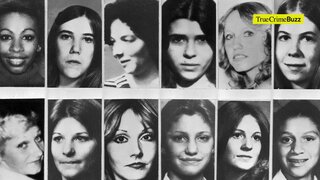Create a free profile to get unlimited access to exclusive videos, breaking news, sweepstakes, and more!
Did The Hillside Strangler Murders Inspire Female Self-Defense Classes?
The new Peacock docuseries "Devil In Disguise: The Hillside Strangler" shows women in L.A. seeking out self-defense classes amidst the killing spree.
The Hillside Strangler case instilled fear in Los Angeles residents in an unprecedented manner. Within the span of just a few months in the late 1970s, 10 women were discovered murdered in the hills surrounding the iconic California city.
In the middle of that disturbing crime spree, women felt they had to take extreme measures to protect themselves, as “The Hillside Strangler: Devil in Disguise,” a new four-part Peacock docuseries, reveals.
The docuseries offers a new, in-depth peek inside the minds of the adoptive cousins behind the spree. Kenneth Bianchi and Angelo Buono impersonated off-duty police officers to lure victims to their death, often after the sun went down. In all, the pair murdered 10 women and girls during their California spree; Bianchi killed another two victims on his own in Washington state.
But before the duo were caught, the bodies of women who had been strangled and often restrained kept appearing on the hillsides of Los Angeles. People around the city — women especially — became increasingly scared with each grim discovery.
While the killing spree began on Oct. 17, 1977, it wasn’t until more than a month later, after at least seven were killed, when the murder spree really made headlines. It was the murders of close friends Dolores “Dolly” Cepeda, 12, and Sonja Johnson, 14, that got the full attention of the media. Their killings, likely because of their youth, were the ones that pushed the case into the spotlight, transforming it into a high-profile one.
Bob Grogan, a retired homicide detective with the Los Angeles Police Department, says that it was after the moniker “Hillside Strangler” came about “when the papers went kind of crazy.” He claims that in turn, fear gripped residents and “created havoc” in the city.
News footage from 1977 included in the docuseries notes that more women than ever before were learning how to defend themselves through self-defense classes.
"There were women running around buying guns, taking classes in Judo and all kinds of self-defense,” Grogan says.
Dr. Lois Lee, an advocate for sex workers and sex trafficking victims, tells the producers of the docuseries “everyone was really on edge and worried that they could be next.”
After murder victim Lauren Wagner, 28, was discovered dead days after the two young friends were found killed, investigators noticed marks indicating the use of handcuffs on her body. They realized that either a police officer or someone posing as a police officer may have been the culprit. As a result, they issued a warning to women, telling them that if they were stopped by officers, they should make sure that they were legitimate. Women were no longer obligated to pull over; they were told they could drive home and then call the police in the name of safety.
The Hillside Strangler case did not ignite the female self-defense movement, though, which actually began in the early 1900s. Later linked with second-wave feminism, the movement became in vogue in the 1960s and 1970s, although this case likely had an effect on their popularity.
Learn more about the Hillside strangler in the Peacock special “The Hillside Strangler: Devil In Disguise,” streaming now.






























